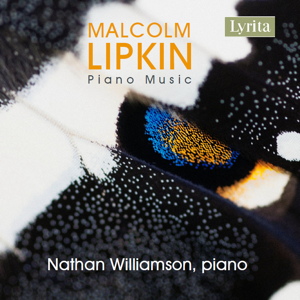
Malcolm Lipkin (1932-2017)
Piano Sonata No 5 (1986)
Piano Sonata No 6, Fantasy Sonata (2002)
Eight Nocturnes (1987-2006)
Nathan Williamson (piano)
rec. 2021, Wyastone Leys, Monmouth, UK
Lyrita SRCD414 [689]
I am beholden to Paul Conway’s fascinating liner notes in my preparation of this review.
Malcolm Lipkin wrote Eight Nocturnes between 1987 and 2006. They were “collected” towards the end of his creative life. Conway has suggested that they present “a lifetime’s creativity distilled into five-minute statements”. As the titles imply, this is night music. The booklet says that Lipkin “deftly probes elements of the subconscious […] playing with appearance and reality, light and dark, tranquillity and menace”. Humour is also mentioned, but I am not sure about this quality. There is little here that is extrovert or bombastic. In fact, the listener may despair of their “predominately hushed and inward looking” nature.
The introspective Nocturne No. 1 is slow and lugubrious, but full of colour. Nods to Beethoven’s Für Elise and Grieg’s Piano Concerto are explained by the dedication of the piece: “To Philip Fowke in honour of Eileen Joyce.” Joyce, the distinguished Australian pianist, had these two works firmly in her repertoire. Equally doleful is Nocturne No.2, which the notes correctly label as “dreamlike”. Nocturne No. 3 has its meditative mood blown away by a very brief, fiery outburst. The same happens in No. 4, where the “insistent, rapidly repeated notes introduce an element of assertiveness” typically absent in this piece. Nocturne No. 5 …interrupted melody was dedicated to Stephen Hough. It balances straightforward pianism with “ornaments and flourishes”. The structural basis of Nocturne No. 6 …glint and shadows seems to be pearls on a string – lots of contrasting figures and phrases, somehow managing to cohere, Nocturne No. 7 has the strange title …dancing figures. Marked Capriccioso, it barely stops being yet another meditation. The sequence is rounded off by Nocturne No. 8 …recollections. I guess that this may include references to the previous numbers. Nathan Williamson plays them all with skill and concentration. Yet, at a first hearing, and without a score, there is a feeling of sameness about these Nocturnes.
Let me turn to the Piano Sonatas. Apart from noting a performance of the Piano Sonata No. 3 in the Netherlands in 1951, the first three sonatas are not mentioned. Even Lipkin’s website does not list the first two. Jeremy Carter premiered the Sonata No. 5 in 1989. There are two movements: Extremely slow and Quite fast. The music of the first movement, often aggressive, contains sequences of repeated chords and “blatant” tremolos. This is balanced by slow bell-like chords. Despite the tempo marking there seems to be quite a lot of rapid music here. Rob Barnett’s recent review correctly discerns a similarity to the piano music of American composers George Antheil and Leo Ornstein. The second movement is toccata-like in its deployment of a breath-taking moto perpetuo. Here and there, Lipkin indulges in “jazzy, syncopated accents”. This clearly complex, technically demanding work strikes a satisfying equilibrium between ferocity and reflection.
The Sonata No. 6 carries the subtitle Fantasy Sonata, a clue as to its effect. It is hugely different than the Sonata No. 5 composed sixteen years earlier. The liner notes describe it as “urbane and poised, unfolding spontaneously and fluently in a single movement”. True, much of this music exhibits a “cool, classical elegance” and a convincing formal structure. Where Sonata No. 5 was typically ferocious, this one is warm and temperate. There are moments of strength and even hardness in the work’s progress, but this is countered by much that is fragile and tender. This remarkable piece entertains and moves.
Paul Conway’s liner notes give a detailed assessment of all the music on this disc. There is also a helpful overview of Malcolm Lipkin’s life and music, and a resume of the pianist Nathan Williamson. Rob Barnett has noted that the sleeve design (of a butterfly wing) looks back to the heady early days of Lyrita recordings, when Keith Hensby designed the covers.
This well-balanced recital gives the listener a splendid introduction to Malcolm Lipkin’s piano music. As far as I can tell, these are all premiere recordings, so there is nothing to compare them to.
John France
Previous review: Rob Barnett
Help us financially by purchasing from




















